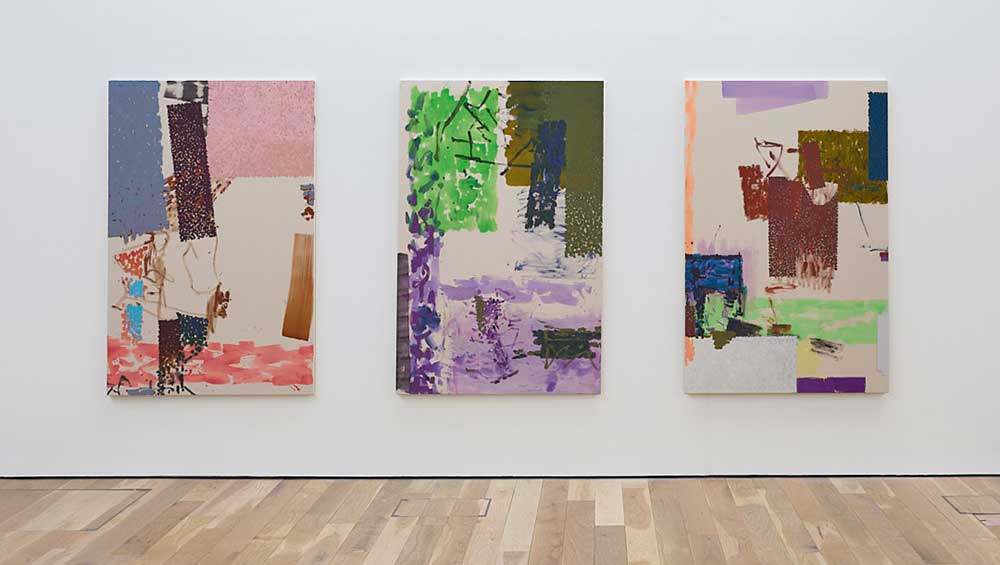
Mary Ramsden. Left to right: Dry white rectangles of moonlight; The end came and went; Like the sound of the wind in a movie. Each 170 x 110 cm, 2023. Installation view, The Reason for Painting, Mead Gallery, Warwick Arts Centre, 2023. Photo: Luke Pickering.
Mead Gallery, University of Warwick
4 May – 25 June 2023
by SAM CORNISH
The Reason for Painting is a chance to see abstract paintings by more than a dozen younger artists in the beautiful triple-height, top-lit spaces of the Mead Gallery at the University of Warwick. Most are in their 30s, with Sam Windett and Pam Evelyn outliers at either end of the scale, born in 1977 and 1996 respectively. They are mainly British or working in Britain, although, for example, Francis Offman was born in Rwanda and works in Italy. The Mead has a history of engagement with abstraction. The University of Warwick has a good collection of abstract painting, formed around a core of works from the 1960s, its foundational decade. More recently, in 2012 the Mead hosted the survey exhibition The Indiscipline of Painting, curated by Daniel Sturgis, which explored critical approaches to modernist painting after the 60s.
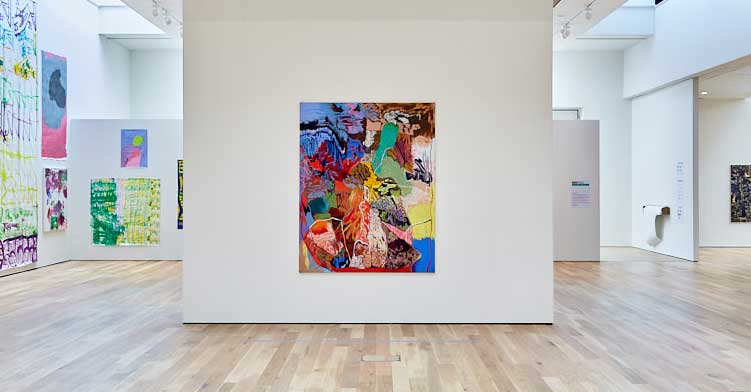
Centre: Rachel Jones, Lick your teeth, they so clutch, 2021. Oil pastel, oil stick on canvas, 159.5 x 199 cm. Installation view, The Reason for Painting, Mead Gallery, Warwick Arts Centre, 2023. Photo: Luke Pickering.
Abstract painting is having something of a moment, following, if not fully displacing, the figurative painting that seemed to be everywhere only a year or two ago, at art fairs or on Instagram. The Reason for Painting overlaps with a cross-generational survey, To Bend the Ear of the Outer World, which opened on 1 June across two of the mega-gallery Gagosian’s London spaces. Earlier this year, the Centre of International Contemporary Art in Vancouver hosted a show entitled New British Abstraction, while the Marlborough Gallery in London staged an underwhelming display of mainly younger painters, most of whom were overpowered by being shown in relation to the late British abstract expressionist painter Gillian Ayres. It is very much an open question how much such exhibitions are evidence of a shift in taste or a market-based fluctuation, but many of the artists involved are serious and talented.
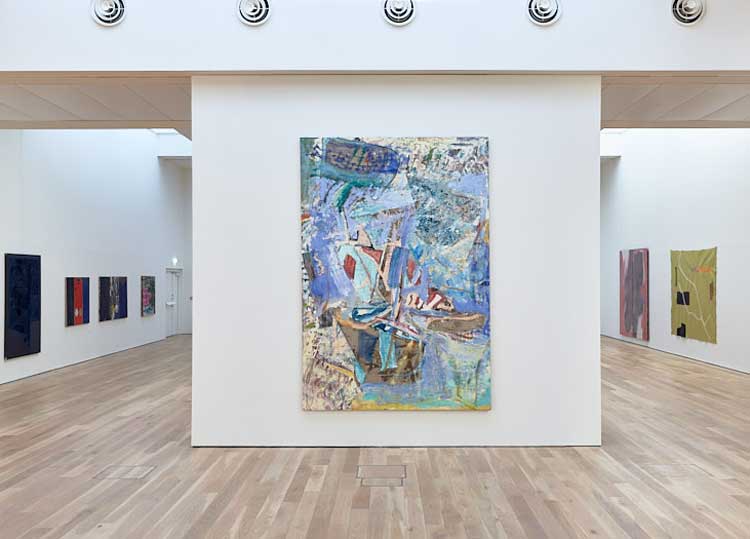
Pam Evelyn, Routine escape, 2022. Oil on linen, 300 x 200 cm. Installation view, The Reason for Painting, Mead Gallery, Warwick Arts Centre, 2023. Photo: Luke Pickering.
A number of the painters at the Mead Gallery have recently attracted significant market attention, most notably Evelyn, Rachel Jones and Jadé Fadojutimi, with some stratospheric auction prices going hand-in-hand with attention from museums and powerful galleries. Oscar Murillo is something of a frontrunner of this group, a well-established international artist for a decade. But he made his name by creating abstract paintings within a framework defined by installation art, whereas the artists at the Mead who have come to attention more recently tend to work solely as painters. Harminder Judge, recently shown in a group exhibition at Pace New York, is perhaps indicative of a shift here, having abandoned a successful career as a performance artist to study at the Royal Academy Schools and devote himself to painting.
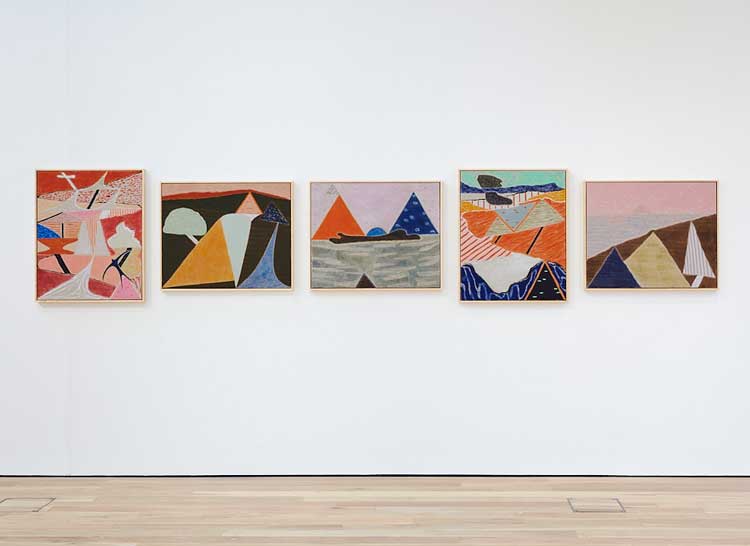
Rob Lyon. Left to right: Emergent; Tremulous in the Lord's Garden; Dioecy has Costs; To Cnut's Rear, Tumuli. Oil on linen. Installation view, The Reason for Painting, Mead Gallery, Warwick Arts Centre, 2023. Photo: Luke Pickering.
Like Judge, many of the artists shown at the Mead have completed postgraduate art education, with more than half studying at either the Royal Academy or the Royal College of Art in London. Rob Lyon, whose whimsical landscape-based paintings are not very abstract, is a self-taught exception. Further outside the professional context is a display of work from The Art Riot Collective, a local collective of disabled and neurodivergent artists. Some members of the group will be working during the exhibition in a space partitioned off from the gallery. Their work sits uneasily alongside the very different concerns of the professionally oriented artists in the show. At the entrance to the partitioned off work-area is a small notice proclaiming: “All Mark-Making Is Valid.” In some senses a liberating idea, it seems to me that abstract painting depends on something like the opposite notion, gaining its power by sorting, even if in a partly subjective and never-finalised manner, marks that are valid from those that are not.
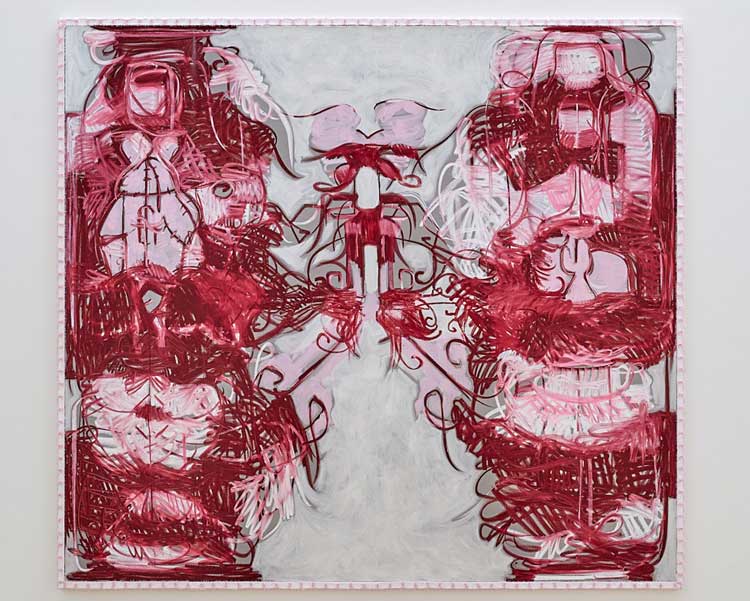
Melike Kara, Khorasan II, 2022. Oil stick and acrylic on canvas, 200 x 220 cm. Installation view, The Reason for Painting, Mead Gallery, Warwick Arts Centre, 2023. Photo: Luke Pickering.
As Martin Herbert has recently suggested, at least some of the attention currently given to younger abstract artists, and perhaps part of what shapes the work they make, can be traced to the increased visibility for abstract art following efforts to broaden the 20th-century modernist canon by including more non-European, non-white and female artists. The most prominent new abstract painters can often be placed in one or more of these identity-based categories. The return to modernism, in which social media also likely plays a part, partially reopens abstract painting as a concern, but brings with it an ambivalent sense of history. The University of Warwick’s foundational collection encapsulated a moment when abstract painting gave confident expression (perhaps unwittingly) to a technologically inspired and forward-looking society. The Indiscipline of Painting, in pointed contrast, presented a range of extremely historically conscious responses to modernist abstract painting, exploring modernism’s legacy and locating it firmly in the past, as an exhausted paradigm.
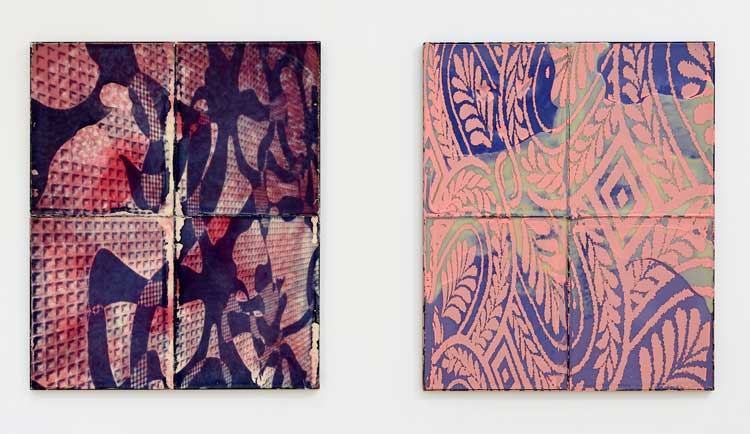
Ruairiadh O'Connell. Left: Paris, 2015, silkscreen on wax with metal tray, 120 x 100 x 2.5 cm. Right: Caesars Palace, 2015, silkscreen on wax with metal tray, 120 x 100 x 2.5 cm. Installation view, The Reason for Painting, Mead Gallery, Warwick Arts Centre, 2023. Photo: Luke Pickering.
The Reason for Painting does not have such a certain sense of the relationship to history. Rather than continuing an earlier tradition or offering a concentrated critique of it, the artists here seem to approach the past of abstract painting in a positive but individual fashion, each looking to their own predecessors. Nor is there not much sense of artists directly, or even indirectly, engaging with each other’s work, despite the common educational context many share. Instead, they appear siloed off, with as many “reasons for painting”’ as there are artists in the exhibition. The main impression at the Mead is of disunity, across the display as a whole and within the smaller groupings of which it is comprised, even if there are some overlapping concerns, such as an interest in pattern and ornament or an attraction to an expressive type of painting mainly defined by line. Perhaps deeper commonalities will gradually become more apparent, but I wonder how artistically sustainable this isolation is in the long-run, even if the market will encourage the few it promotes to maintain and protect their own brand-identity.
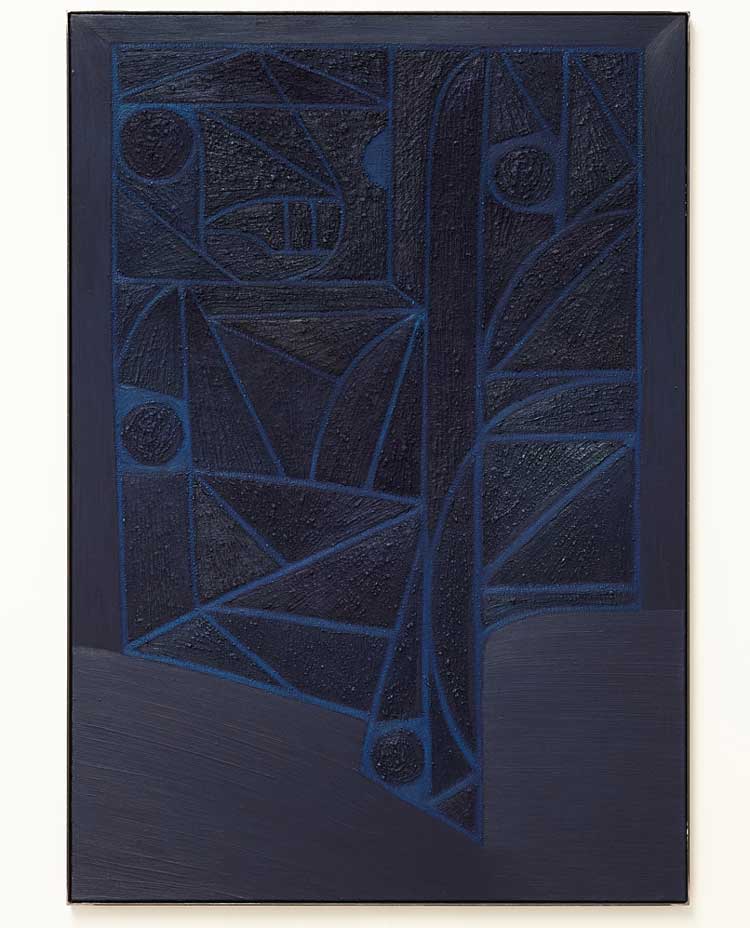
James Collins, Liquid Engineers 58, 2022. Acrylic and oil on canvas, 180 x 125 cm. Installation view, The Reason for Painting, Mead Gallery, Warwick Arts Centre, 2023. Photo: Luke Pickering.
Of the painters who are drawn to pattern, including Melike Kara or Ruairiadh O’Connell, I most enjoyed the two dense, dark and richly encrusted and enigmatic paintings of James Collins, a new name to me. Windett also aims at an enigmatic image, while Mary Ramsden’s three paintings, hung almost as a triptych, deftly balance irony and directness, pure abstraction and intimations of “real-world” interiors.
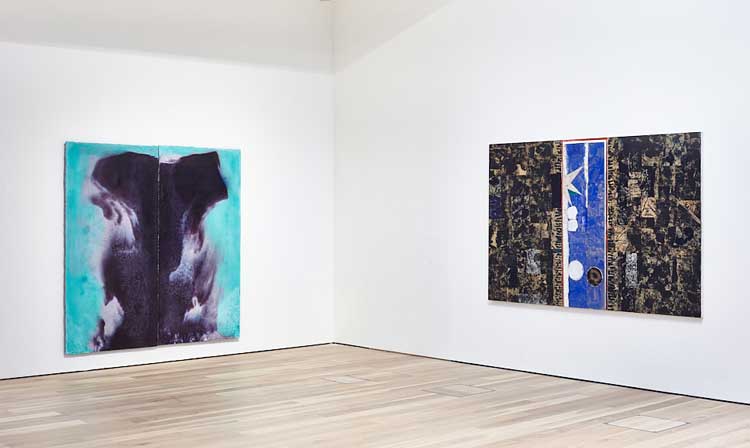
Left: Harminder Judge, Untitled (split cane and rising flame), 2021, plaster, polymer, pigment, scrim, oil, wax, 203 x 198 x 6 cm. Right: Sam Windett, Triptych (Star), 2023, Oil, acrylic, collage paper and canvas on linen, 235 x 153 cm. Installation view, The Reason for Painting, Mead Gallery, Warwick Arts Centre, 2023. Photo: Luke Pickering.
Seeing the painterly abstractions of Evelyn, Jones and Fadojutimi near, if not quite alongside, each other, was illuminating. It was a shame that, as with some other artists in the show, each was represented by only a single painting, although the University of Warwick, by buying early, managed to secure a work by Fadojutimi for its collection before her prices flew out of reach. Evelyn is the most natural and inventive painter of the three, perhaps in the whole show, even if, or perhaps because, she is the most fully immersed in previously established languages of abstract art. Strangely, the example of the hugely underappreciated painter Gary Wragg, now in his 70s, seems present in Jones’s images, down to specific structures and colour combinations. Yet Jones, partly by avoiding dramatically gestural mark-making, gives her images a hallucinogenic landscape-redolent intensity that is very much her own.
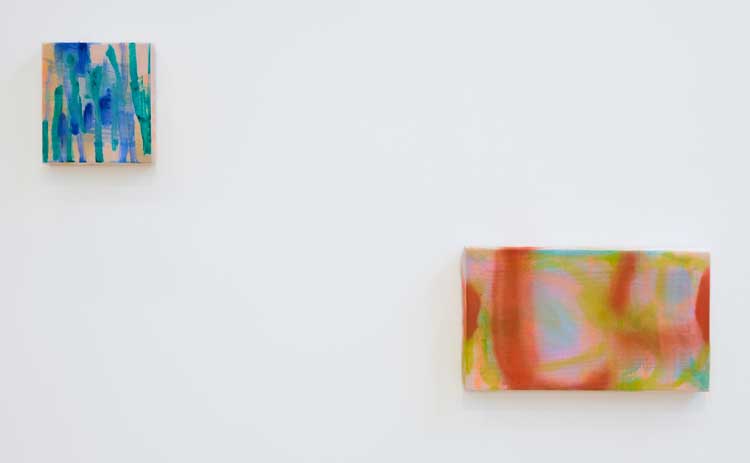
Betsy Bradley. Left: Through the Singing Trees, 2022. Oil on voile, 24.5 x 22.5 cm. Right: Secret Whispers, 2022. Acrylic and spray paint on voile, 29 x 51cm. Installation view, The Reason for Painting, Mead Gallery, Warwick Arts Centre, 2023. Photo: Luke Pickering.
The juxtaposition of Judge and Betsy Bradley is the most successful combination at the Mead, and the highlight of the exhibition. They are among the most well-represented painters in the show, including a monumental multipanel work by Judge that dominates one half of the gallery. Elsewhere, Judge is shown next to a clear but delicate image by Offman, whose work I would have liked to see more of. Judge and Bradley are concerned with a fluid image that seems to exist within a luminous surface, as if kept behind a pane of glass or a sheet of gauze. Bradley is more willing to draw the viewer in, whereas Judge’s images seem almost to disappear if you get too close. Bradley’s images open, optimistic and playful, are more gestural, while Judge’s are shadowy, shifting and quasi-apocalyptic. Both exploit the mysteriousness or intrigue of employing gestural-type marks or expanses of colour within otherwise distanced paintings.
It would be difficult to call the combination of painterliness and distance new. But here it does feel in some way contemporary, connected perhaps to all-pervasive experiences of screens, or to a heightened concern many people seem to have with their emotions but also a sense that they need to be protected, carefully separated off from the environment in which we spend our lives. Indeed, the blurb for the exhibition suggests that The Reason for Painting is a place to “momentarily escape the social and economic crisis we are living in today”. In the isolation of the painters from each other, in their historical placelessness, and with the intrusion of the market into the early careers of some, I’m not sure the gallery is such a safe space.